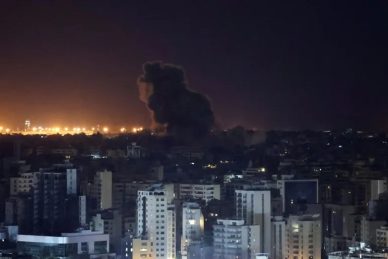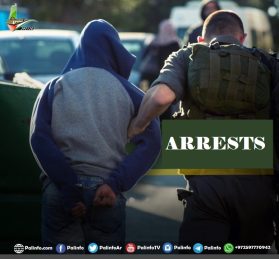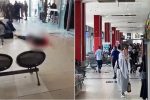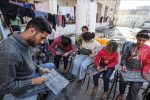WEST BANK, (PIC)
The use of fighter jets by the Israeli occupation army for the first time since 2000 to bombard a popular café in Tulkarem city marks the peak of Israeli escalation in the occupied West Bank, resembling the ongoing genocidal war on the Gaza Strip since October 7, 2023. The bombing targeted residential areas, including a popular café in the Al-Hamam neighborhood of Ain Shams refugee camp, resulting in 18 martyrs, including Ghaith Radwan, one of the leaders of the Tulkarem Brigade, while the occupation army claimed it targeted an operative in Hamas. Meanwhile, the West Bank is witnessing an escalation in Israeli incursions, killings, and arrests, resembling an unannounced war relying on selective strikes and military operations that are confined in place and time, alongside unleashing settlers in the West Bank to carry out a series of assaults that serve the Israeli agenda.
The Israeli military escalation is not solely linked to the genocidal war on Gaza, although its intensity has increased since the outbreak following the Al-Aqsa Flood operation launched by the Al-Qassam Brigades. The rise of resistance in northern cities of the occupied West Bank and the emergence of the Jenin Brigade and the Lion’s Den since 2021, in contrast to the surge of settler attacks on Al-Aqsa Mosque and attempts to enforce temporal and spatial division, has been a direct cause for the initiation of the Israeli “mowing the grass” strategy, which had previously been used against the resistance in Gaza. This strategy aims to exhaust the resistance and prevent it from catching its breath through repeated military operations that deter the resistance from contemplating a return to this activity, preventing its strength from growing into a general uprising, without these operations leading to an explosion in the West Bank against Israel.
The occupation’s resort to maximum aerial force in striking Al-Hamam reflects a desire to uproot resistance from the West Bank, a point emphasized by Israeli War Minister Yoav Gallant during his assessment of the situation in northern West Bank on September 4. He stated, “When we mow the grass, there will come a moment when we uproot the roots, and this must be done. We use airstrikes everywhere when necessary to avoid risking the lives of our soldiers; there is no other solution, and we must use everything necessary with full force.”
Waves Breaker
Regarding the timeline of escalating Israeli crimes in the West Bank through military attacks, it began on March 31, 2022, when the occupation army launched an offensive against the West Bank and the extension of the separation wall, naming it “Waves Breaker,” aimed at limiting resistance operations. The aggression focused on the cities of Jenin and Nablus, leading to the martyrdom of more than 100 Palestinians. During the incursion, the occupation forces used drones, a step not witnessed in West Bank cities since the Defensive Shield operation. The occupation army mobilized around 25 battalions of ground forces for this operation, in addition to special forces for arrest missions and countering resistance operations.
The Israeli army mobilized around 5,000 soldiers and 8,000 members of the occupation police, utilizing Unit 8200 and the air force for monitoring and surveillance. At that time, the occupation forces did not officially announce the end of the operation, leaving the West Bank in a state of escalation. During this period, the rate of Israeli assaults and arrests against Palestinian citizens increased, while the resistance responded with a series of heroic operations.
Summer camps
On August 28, 2024, the occupation army launched a military assault, the largest since the Defensive Shield operation in 2002, which included a siege and attacks on the cities of Jenin, Tulkarem, Tubas, and towns in the northern occupied West Bank, aimed at targeting the resistance fighters there.
The occupation army launched the aggression using the Kfir Brigade (an infantry brigade), along with four battalions from the border guards, units of undercover forces, elite troops, and engineering units, in coordination with the General Security Service (Shabak), supported by the Israeli Air Force, which deployed military helicopters, fighter jets, and drones to provide cover for the ground forces.
In a mirrored scenario to what is happening in Gaza, the occupation army began its aggression using combat methods that had not been previously employed, such as airstrikes from F-16 fighter jets that bombed several towns and refugee camps, from Jericho in the south to Jenin in the north. During this, tanks and massive bulldozers (D9) entered the refugee camps, particularly in Jenin, Balata, Nour Shams, and Al-Auja. The objective shifted from merely arrests to targeted assassinations, resulting in the demolition of hundreds of homes and most of the infrastructure.
In response to this operation, the Al-Qassam Brigades, Al-Quds Brigades, and Al-Aqsa Martyrs Brigades announced a joint operation called “Terror of the Camps,” which included gunfire, clashes, and targeting military vehicles.
Since the beginning of the war on Gaza, the assaults by the occupation and its settlers in the West Bank have resulted in the martyrdom of 741 Palestinians, including 160 children, with over 6,200 others injured, and more than 11,000 Palestinians arrested, according to official Palestinian sources. In contrast, the West Bank witnessed 4,973 operations against occupation soldiers and settlers, resulting in the deaths of 38 Israelis, including 15 soldiers and security personnel, while 285 others were injured, according to data published by the Israeli website “Walla.”
Wave of assassinations
Between the “Waves Breaker” and the summer camps, the occupation army executed multiple waves of assassinations of members of resistance cells, starting with martyr Abdullah Al-Hosari, followed by a large group that included Ibrahim Al-Nablusi, Farouk Salama, Naif Abu Suwais, Saif Abu Labda, Dawood Al-Zubeidi, Wadi Al-Huha, Tamer Al-Kilani, Adham Mabrouka, Mohammed Al-Dakheel, Ashraf Mabsalet, Mohammed Al-Azizi, Abdulrahman Sobhi, Saed Al-Koni, Ezzedin Awad, Jihad Shihada, Moamen Bal’awi, Mohammed Jlamna, Mohammed and Basel Al-Ghazawi, Mahmoud Hashash, Mohammed Abu Mustafa, Mahmoud Zahid, Mohammed Masimi, Wissam Al-Hanoun, Alaa Nazzal, and Anas Dawood.
Field reports indicate that since the onset of the genocidal war on Gaza, the occupation army has carried out 49 airstrikes in the occupied West Bank, resulting in 175 martyrs.
Settler attacks
As for settler violence and settlement expansion, attacks have surged to unprecedented levels amid near-total impunity, as they continue their assaults on cities and villages in the West Bank, wreaking havoc on Palestinian lives and properties, supported by the far-right Israeli government.
A report by the International Crisis Group, titled “Rooting Out Israeli Settler Violence,” confirms the increase in settler attacks in the West Bank since the Netanyahu coalition government took power in December 2022, which includes ministers from the far-right. It notes that the intensity of these settler attacks escalated following Israel’s genocidal war on Gaza, as settlers felt emboldened to retaliate for the deaths of Israelis during the Al-Aqsa Flood operation carried out by Hamas.
Data provided by the United Nations Office for the Coordination of Humanitarian Affairs (OCHA) to the International Crisis Group shows that settlers committed 1,264 assaults between October 7, 2023 and August 12, 2024.
According to the report, the acts of hostility, often carried out by armed settler gangs, range from verbal intimidation and harassment to physical assaults, livestock theft, and attacks on Palestinian property, including uprooting farmers’ olive trees and denying them access to land and water. They also set fire to homes, fields, and vehicles, as occurred in Qalqilya when dozens of masked settlers stormed the village of Jit on August 16, burning several homes and vehicles.
The report states that settlers seized thousands of dunums of Palestinian land over the past year alone, forcing more than 1,300 Palestinians to leave their homes. According to the international organization, the rate of settler violence has increased in parallel with the expansion of settlements in the West Bank in recent years, which has been encouraged by successive Israeli governments, particularly under Netanyahu, where settlements have significantly increased.
Unlimited settlement
An analysis conducted by the BBC shows that the number of random settlement outposts has rapidly increased in recent years, with at least 196 outposts across the West Bank, 89 of which were established since 2019, while 29 outposts were set up in 2023 alone, surpassing any previous year.
These outposts, which can be farms, clusters of houses, or even groups of caravans, often lack clear boundaries and have recently taken on an escalating character known as pastoral or agricultural settlement, where the occupation government supports and arms settler militias to attack Palestinians in gatherings and villages, pushing them to migrate after destroying and burning their homes, seizing thousands of dunums of their grazing lands and water springs, and establishing settlements on their land under the pretext of providing grazing areas for settlers’ livestock.
Data published by the Palestinian Center for Israeli Studies shows that settler herders are seizing over 300,000 dunums, approximately 10% of the area of the West Bank, which exceeds the total area controlled by all Israeli settlements since 1967. Currently, around 300,000 settlers live in occupied East Jerusalem, and about 500,000 settlers reside in the rest of the West Bank settlements, which include 300 settlements.
The Israeli organization “Peace Now” estimates that about 500 settlers live in random settlement outposts, while another 25,000 live in larger outposts, noting that these random outposts often receive implicit support from the occupation government before being retroactively legalized.
A historic opportunity
Settlers, particularly those belonging to religious nationalist currents and those dubbed secular, believe the current period is a historic opportunity they have awaited since the settlement process began in the 1970s to realize the idea of “Greater Israel.”
Politicians and analysts estimate that Netanyahu’s extremist government is trying to impose its strategy to Judaize the entire West Bank and expel Palestinians from it in tandem with the genocidal war in Gaza, supported by the US.
Dr. Mustafa Barghouti, Secretary-General of the Palestinian National Initiative, states that what is currently happening is a systematic genocide against Palestinians in the West Bank, which he says is entirely occupied by Israel. He added during his participation in an Al Jazeera program titled “Gaza, What Next?” that the occupation’s strategy has become completely clear; Benjamin Netanyahu and his fascist government are attempting to transfer the war in the Gaza Strip to the West Bank, as they now bomb Palestinians there, especially in the camps, with aircraft and drones.
He pointed out that what the occupation is doing against Palestinians in the West Bank camps coincides with killing operations carried out by settlers to dangerously and diversely expand settlements, including pastoral settlement by deploying settlers along with their sheep to control as much land as possible.
The International Court of Justice issued its opinion on July 19 regarding the legal consequences of Israeli occupation policies and practices in the occupied Palestinian territories since 1967 and the consequences of the occupation’s behavior on other states, following a legal process that lasted 18 months. The court confirmed that the Israeli occupation of Palestinian territories, ongoing for decades, is illegal and must end as soon as possible.















